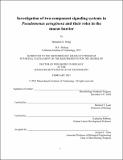| dc.contributor.advisor | Michael T. Laub and Katharina Ribbeck. | en_US |
| dc.contributor.author | Wang, Benjamin X. | en_US |
| dc.contributor.other | Massachusetts Institute of Technology. Department of Biology. | en_US |
| dc.date.accessioned | 2021-05-25T18:21:27Z | |
| dc.date.available | 2021-05-25T18:21:27Z | |
| dc.date.copyright | 2021 | en_US |
| dc.date.issued | 2021 | en_US |
| dc.identifier.uri | https://hdl.handle.net/1721.1/130821 | |
| dc.description | Thesis: Ph. D., Massachusetts Institute of Technology, Department of Biology, February, 2021 | en_US |
| dc.description | Cataloged from the official PDF of thesis. | en_US |
| dc.description | Includes bibliographical references. | en_US |
| dc.description.abstract | All living things must be able to sense and respond to signals in their environment in order to grow and survive. For bacteria, a common means through which this occurs is via two-component signaling systems, which are typically comprised of a membrane-bound histidine kinase that senses external cues signals, and a cognate cytoplasmic response regulator that triggers changes in gene expression. The importance of these systems is highlighted by the fact that they have been identified in the vast majority of sequenced bacteria. However, despite their prevalence, much remains to be discovered about these sensory systems. In particular, both the actual processes that these systems control, along with the signals that they sense and respond to, remain poorly characterized in many cases. | en_US |
| dc.description.abstract | In this work, I further characterize two-component signaling systems in the opportunistic pathogen Pseudomonas aeruginosa, which is most well-known for chronically infecting the lungs of patients with cystic fibrosis. I begin by screening a collection of in-frame deletion mutants of each histidine kinase in the PA14 strain against a dozen virulence-associated phenotypes, including different types of motility, biofilm formation, virulence factor production, and antibiotic resistance. Through this approach, I identify nearly two dozen of these proteins as important regulators of virulence. As P. aeruginosa is a human-associated mucosal pathogen, I next search for host-derived signals in mucus that act through these sensory systems in P. aeruginosa. I identify mucins and their associated glycans as signals that act through the RetS histidine kinase and the GacS-GacA two-component signaling system. | en_US |
| dc.description.abstract | One major output of this signaling is the downregulation of the type VI secretion system, which suggests that mucin glycans may serve as host-derived "safety signals" that suppress microbial competition under non-dysbiotic conditions. Finally, I characterize the molecular mechanisms by which RetS inhibits GacS activity to better understand the unusual interactions between these two histidine kinases. Overall, this work underscores the diverse and important roles that two-component signaling systems play in bacteria, and begins to shed light on how microbes like P. aeruginosa utilize these systems to sense and respond to signals in the host. | en_US |
| dc.description.statementofresponsibility | by Benjamin X. Wang. | en_US |
| dc.format.extent | 201 pages | en_US |
| dc.language.iso | eng | en_US |
| dc.publisher | Massachusetts Institute of Technology | en_US |
| dc.rights | MIT theses may be protected by copyright. Please reuse MIT thesis content according to the MIT Libraries Permissions Policy, which is available through the URL provided. | en_US |
| dc.rights.uri | http://dspace.mit.edu/handle/1721.1/7582 | en_US |
| dc.subject | Biology. | en_US |
| dc.title | Investigation of two-component signaling systems in Pseudomonas aeruginosa and their roles in the mucus barrier | en_US |
| dc.type | Thesis | en_US |
| dc.description.degree | Ph. D. | en_US |
| dc.contributor.department | Massachusetts Institute of Technology. Department of Biology | en_US |
| dc.identifier.oclc | 1252627470 | en_US |
| dc.description.collection | Ph.D. Massachusetts Institute of Technology, Department of Biology | en_US |
| dspace.imported | 2021-05-25T18:21:27Z | en_US |
| mit.thesis.degree | Doctoral | en_US |
| mit.thesis.department | Bio | en_US |
